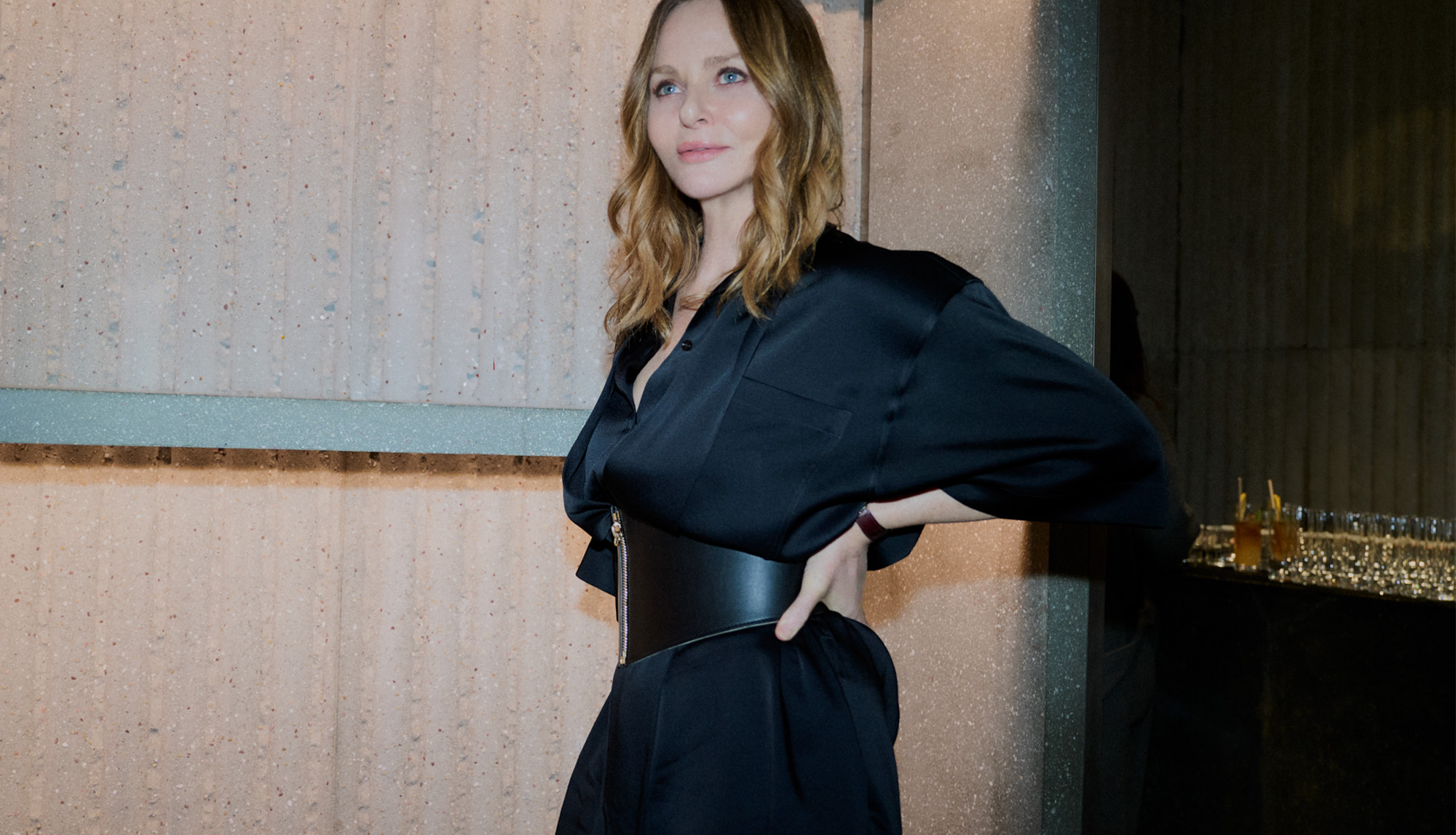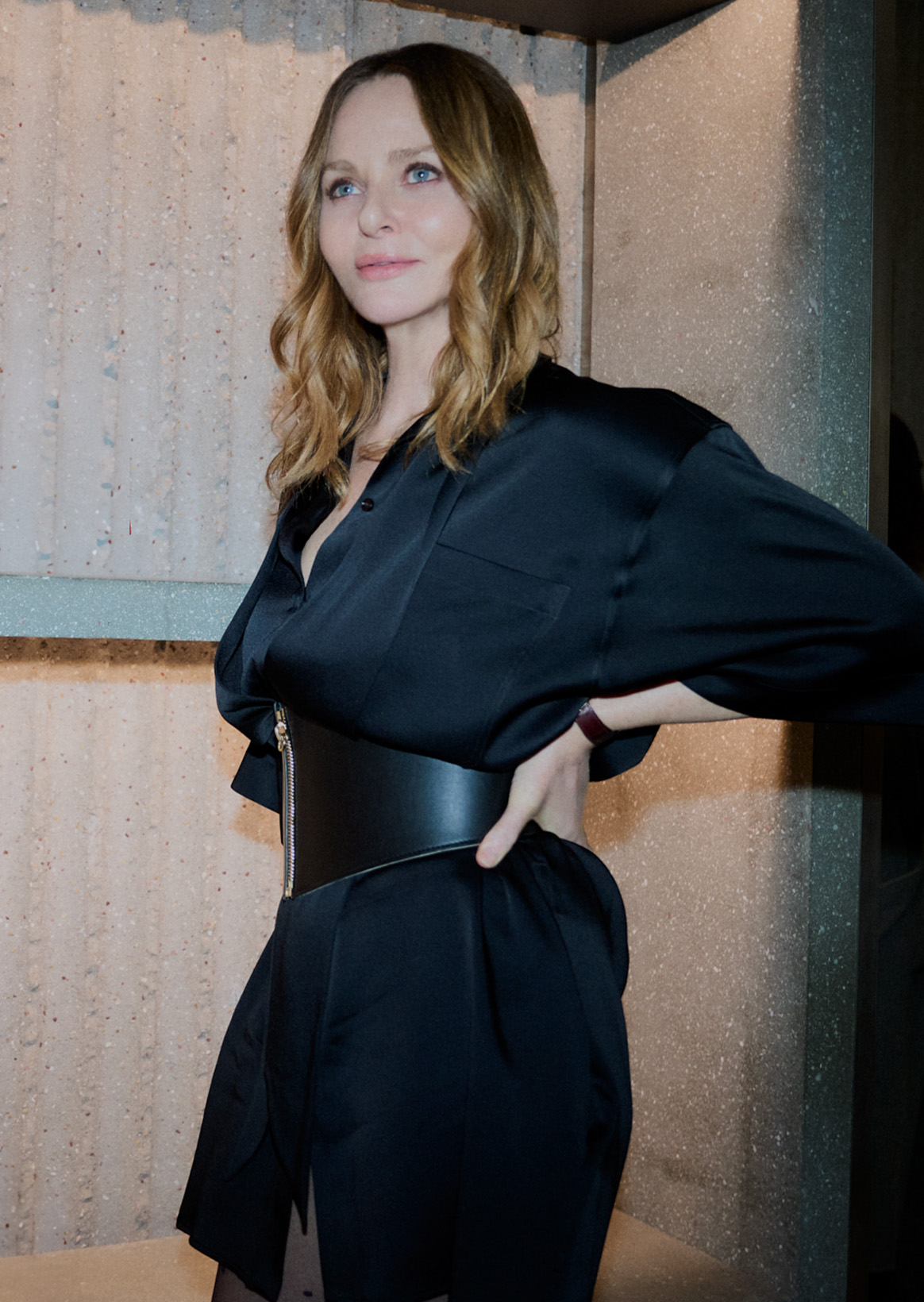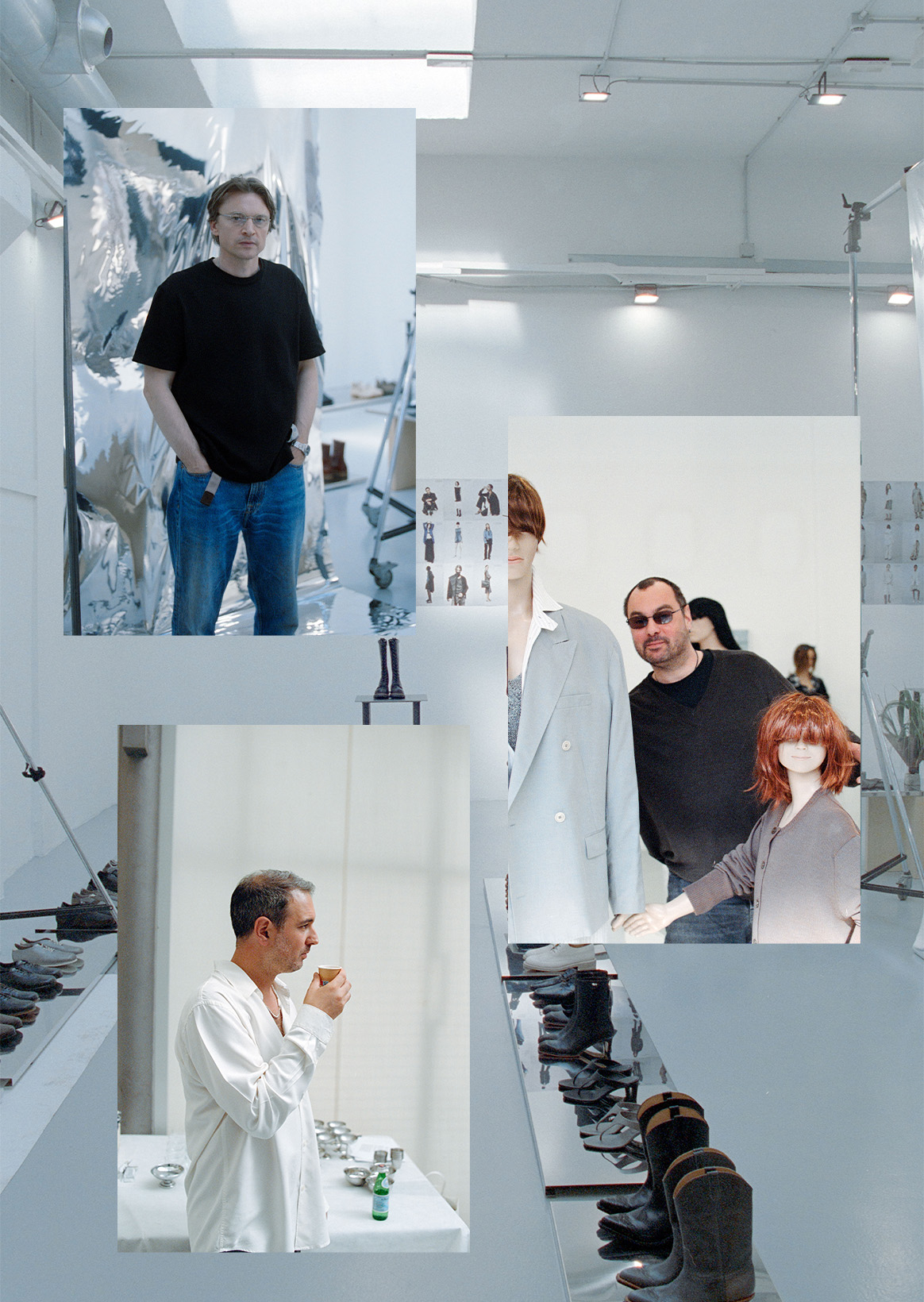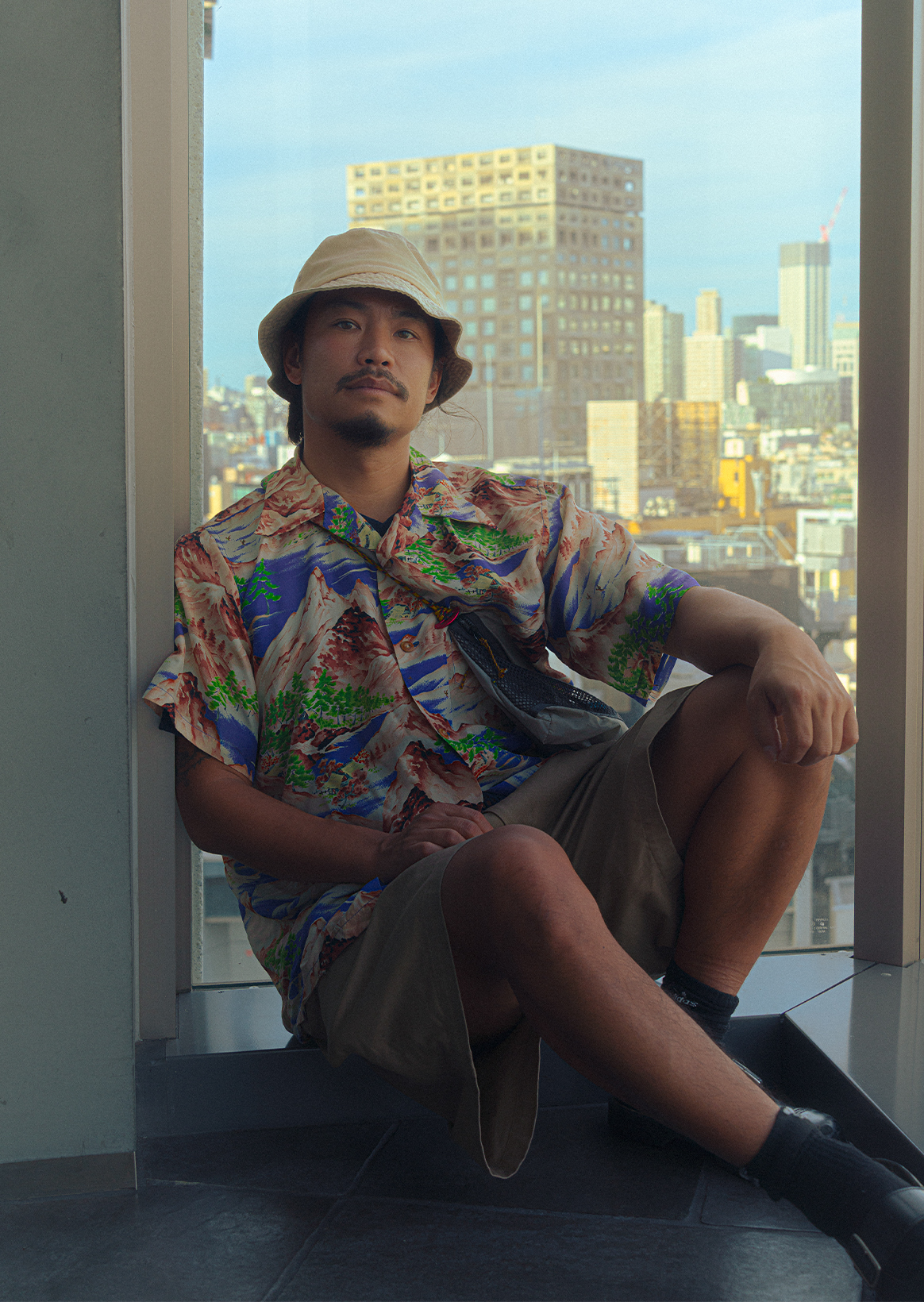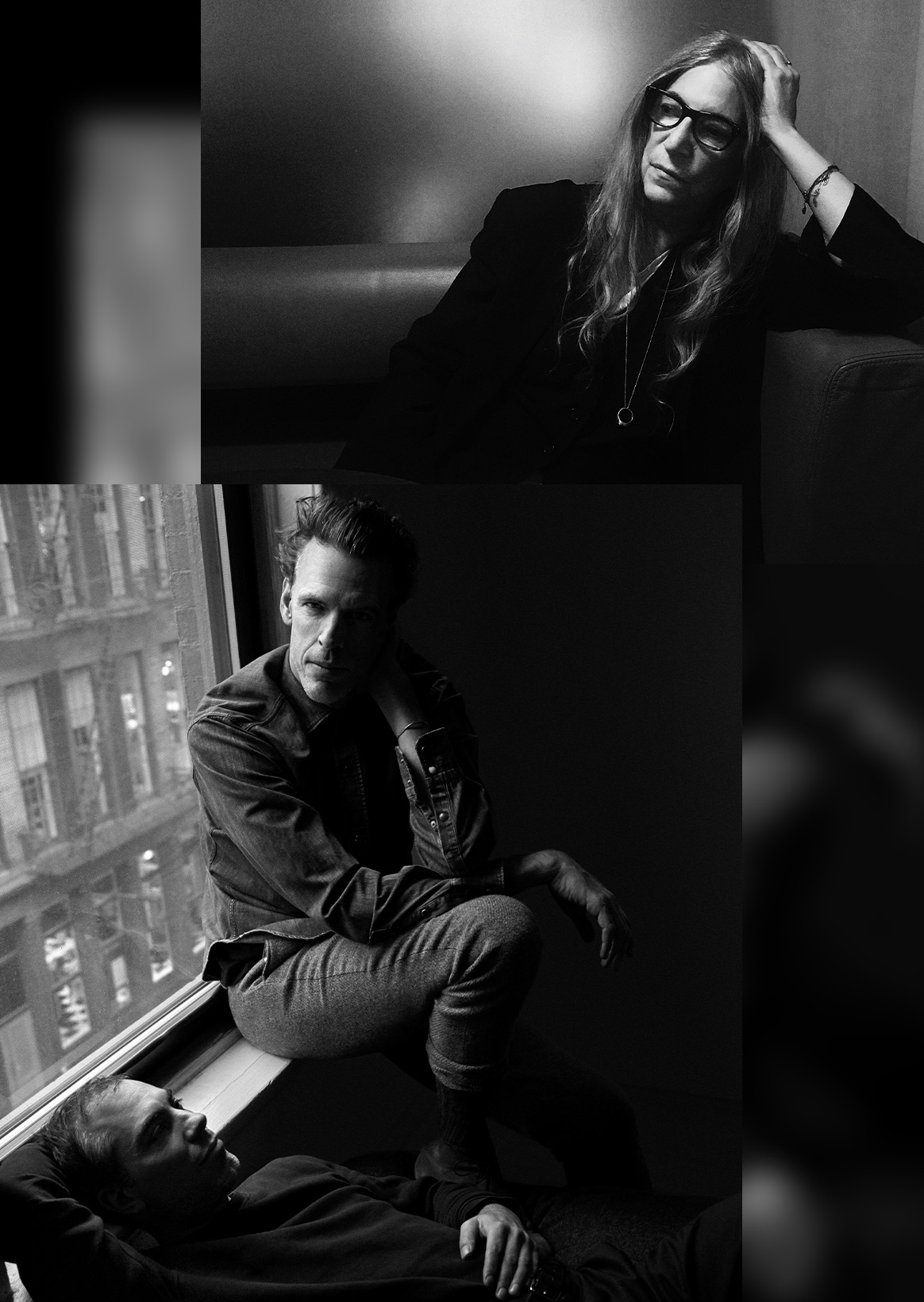Stella Mccartney founded his own luxury fashion house, Stella Mccartney, in London, England in 2001. At the 2025 Summer Runway show held at Paris Fashion Week, inspired by Jonathan Franzen of the birdwatching family's book "The End of the End of the Earth," he developed a collection made of 96% environmentally friendly materials without harming creatures. On April 18th (Fri), a new store of Stella Mccartney will open in Shibuya PARCO. <Adidas> We celebrated RASANT's Japanese limited kolor (BLACK) launch in collaboration with her, and asked her who came to Japan about the environment that fostered unique creativity and her own brand.
※ The English version is available below.
- Photo
- Sachiko Saito
- Text
- Tomoko Ogawa
- Edit
- RIDE Inc.
——What are the things that have influenced you most since you were young?
The decision to create a sustainable brand was easy. That's the environment where I grew up and I was taught since I was young. My best memory when I was 4 or 5 years old was that I realized that my mother and father shared a wardrobe. There was an absolute Ann Dorogeny (with the characteristics of both sexes). It was the time of Gramlock, where Wings played an active part. Half of the clothes I thought were my mother's, my father actually wore them. Since then, when I found a flower-patterned shirt from my mother's archive and thought, "This blouse is so cool!", I saw a picture of my father wearing it. Years ago, it's very modern, and it's still a cutting-edge topic. I think that being surrounded by clothes since I was young has had a great influence on myself and the way I work now.
——Do you have any music left in your heart?
I always go back to my parents' music, especially when I was touring with Wings. That was my childhood. Riding a horse in the Scottish wilderness or a tour bus on the way to the next gig. It was an incredibly exciting and emotional time in my life. Their music is inscribed in my DNA as a designer and as a human being.
——Please tell us about the environment in which you have nurtured your own originality and creativity.
I think there are interesting similarities between fashion design and architecture, but when I was at Central Saint Martins, I realized that I was not learning the technical aspects of fashion design. I was more focused on being creative than learning technical things like cutting the pattern of tailored jackets that I wanted to do. So I went into Savile Row. I remember working with people like “architects” in the fashion industry. It’s something that supports the foundation. Making a jacket is like building a building, and it was so interesting that I trained there for three years and almost learned how to make a steam habit. The technology I’ve learned over the past three years is still in my base, and I think tailoring will continue to be completely part of Stella Mccartney’s DNA.
——What are the important moments and events that have become game changers for you?
The graduation show at Central Saint Martins was quite important. Kate Moss, Naomi Campbell and Yasminlubon were there as models and wearing my clothes was still vividly remembered and unbelievable.
——What do you think Stella Mccartney, a brand that continues to balance fashion and sustainability, value?
Our values are rooted in a bold, powerful, and always elegant Stella Woman who is not afraid to send a serious message. I want women to feel confident and powerful, and I try to make clothes unique and easy to use. We are also conscious of being an ethical and modern company, and always consider the impact on the resources we use and the environment. We are very proud that the Stella Mccartney brand is innovating new ways to become more sustainable, from design to store practice to product manufacturing.
——Brands and companies also reflect your own way of life.
I'm a vegetarian for life and I don't use any leather, feathers, furs or exotic skins in my collection. Not only that, but we are working with the next generation of innovators to create alternatives that are kind to living things and Mother Earth. The SOS Fund, which I co-founded, helps people with these sustainable visions and is already helping to market new materials such as KelsunTM Seaweed Yarn (a seaweed-derived bio-based material with a texture similar to yarn) and Protein Evolution (an infinitely recyclable polyester recycled from plastic waste using AI and enzymes). I actually practice it every day at Stella because of my speech.
——Based on the production background that puts animal welfare and environmental protection first, what do you think about the subsequent impact on the people wearing it and society?
From the beginning, cherishing animals has driven my choices in my personal life and my vision for the brand Stella Mccartney. When I read the UN’s Livestock’s Long Shadow 17 years ago and linked this spirit to the environmental impact of the livestock industry, it all made sense.
Fashion is one of the most harmful industries to the planet. Livestock accounts for about 14.5% of global greenhouse gas emissions, which is more than 13% of the transportation industry. This is the origin of leather. Leather not only promotes the destruction of tropical rain forest through land development to raise cattle, but also releases about 300 kg of toxic chemicals into the environment and flows into local water systems. Leather also needs to be licked with carcinogenic chemicals, which in many cases significantly reduces the lifespan of factory workers in the poorest countries. It’s cruel at every level.
More than a billion animals are bred and slaughtered each year to supply leather to the fashion industry. Therefore, I think the most important thing that the general public, corporations, and governments should pay attention to is the livestock industry and its impact on our environment and industry. Companies should break away from these traditional harmful materials and methods that hurt workers and animals. We also need to go beyond the limited materials that the industry has traditionally handled, and be creative and innovative in alternatives. If we work together to achieve these goals, we can not only take them from Earth, but actually start a business in a way that regenerates them.
——As consumers, can we do something?
You also play an important role to play by asking brands and governments for transparency and accountability. On the other hand, governments need to create incentives for companies to operate in a more sustainable way. For example, in the United States, my brand is subject to a tax of up to 30% when importing goods made from Vee gun material instead of leather. This is a direct result of lobbying in the leather industry and is contrary to our common goal of combating climate change and protecting the planet for future generations.
——Are there any materials development or projects that are particularly focused on right now?
The new 2025 Summer Collection is made of 96% of environmentally friendly materials, and we are very proud to be the most sustainable collection ever. The runway show was inspired by the author and birdwatching family’s Jonathan Fransen’s book The End of the End of the Earth, celebrating birds and calling for action. Given the fact that more than 3.4 billion birds are injured or killed each year, the 2025 Summer Collection uses no leather, feathers, furs or exotic skins, instead of using innovative materials from Kruelty Free, which has not been experimented with animals in any phase before the product reaches the consumer’s hands.
Animal-derived leather alternatives include the world's first handbag using Hydefy, KelsunTM garment (the first commercially available seaweed-based textile as a luxury item), and a cloud-like knit spun from PEEKABOO recycled nylon yarn. The pigeon motif jewelry is made from gold and silver recycled from electronics and medical waste in collaboration with 886 by The Royal Mint. Supporting the market entry and scale expansion of the next generation innovators is very important to me, and it was a really fun opportunity to be able to handle these amazing textiles this season!
——What are the unforgettable words you have received in your past activities?
He was called "Eco-Fair"! It is impossible to make a fashion brand successful without using animal materials. Even though I kept saying that, I did it. I think that's the most modern thing we've ever done as a brand. We have proven that we can make the impossible possible and achieve beautiful and desirable luxury without harming animals or the earth. Things are changing little by little, but we need more people to walk with us. There’s so much more to do!
——What do you think is necessary to continue doing the work you really want to do in your life?
Don't change the way you work even if you are told that your business will not succeed if you stick to your beliefs and do things in your own way. I feel that what we have done at Stella Mccartney and what we have been doing since our founding have finally been recognized and taken seriously. That's a great honor. This situation gives us a great platform to encourage and discuss other ways of doing business in the fashion industry to challenge the status quo and have a positive impact on the planet.
——What are your impressions of Japan and your memories of your visit to Japan?
I have always loved Japanese culture, fashion, music and art. One of the memories that I remember when I came to Japan is that I met my best friend Michi Nara while I was in Tokyo. He is a great artist and I feel we share a similar vision and values.
Stella McCartney established her eponymous luxury fashion house, Stella McCartney, in London in 2001. Since then, she has championed the coexistence of sustainability and fashion as the core philosophy of her label. At the Summer 2025 runway show during Paris Fashion Week―drawing inspiration from author and birdwatcher Jonathan Franzen’s book The End of the End of the Earth―she presented a collection made with 96% environmentally conscious materials, produced without harming any living creatures. On Friday, April 18, a new Stella McCartney store will open in Shibuya PARCO. Visiting Japan to commemorate the launch of a Japan-exclusive color (BLACK) of RASANT, a collaboration with Adidas, she spoke about the environment that shaped her distinctive creativity, as well as her thoughts on the brand.
——What has had the greatest influence on shaping who you are since childhood?
The decision to create a sustainable brand was easy; it’s what I grew up with and what I was taught from a young age. Some of my biggest memories from when I was four or five year old involve sitting in my parents’ wardrobe, and what was fascinating was I realised my mum and dad shared it. There was this absolute androgyny. It was this period of glam rock, during Wings. Half the things I assumed were mum’s, dad was actually wearing as well. They would swap. I’ve since worn a flowery shirt out of the archive and thought, ‘Oh look at this blouse of my mum’s, it’s so cool!’ Then we’d find a photo of my dad wearing it. It’s so modern; this was years ago, but today it’s a cutting-edge conversation to have. So, this upbringing and being around clothes from a very young age was a huge influence on me and has heavily inspired how I work today.
——Are there any films, music, or books (including photography books) that have left a lasting impression on you?
I always go back to my parents’ music – especially their time when they were touring with Wings. That was my childhood: going from riding on horseback in the wilds of Scotland to being on a tour bus on the way to the next gig. It was an incredibly exciting and emotional time in my life. Their music is in my DNA as a designer and a person.
——Could you share the environments, experiences, or things that have nurtured your originality and creativity?
I like to think that there are interesting similarities between fashion design and architecture in that when I was at Central Saint Martins, I realised that I wasn't learning the technical side of fashion design. The focus was on being creative rather than learning the technicalities, such as cutting patterns for a tailored jacket, for example, which is what I wanted to do, so I went into Savile Row. I remember working with those guys who I thought were like the builders of the fashion industry – you know, the nuts and bolts. Making a jacket is really like building a building, and it was just fascinating to me. I did that for three years, and I just about learned how to set a steam edit. I am constantly referring back to the skills I learnt in those three years, and tailoring is and always will be completely part of the Stella McCartney DNA.
——Can you tell us about a defining moment or event that was a game-changer for you?
I would say my graduation show from Central Saint Martins was pretty major. Having Kate, Naomi, and Yasmin there, wearing my pieces, will forever be something I am incredibly proud of.
——Your brand is well established as one that balances fashion and sustainability. What are the core values that Stella McCartney holds dear?
Our values are rooted in our Stella women – bold, badass, and unafraid to address serious messages, but always with a lightness of touch. I want them to feel confident and powerful, but with a signature effortlessness and ease. We are also committed to being an ethical and modern company, taking full responsibility for the resources we use and the impact we have on the environment. I am so proud of how we are constantly innovating new ways to become more sustainable, from designing to store practices and product manufacturing.
——Your brand and company reflect the very way you live your life, don't they?
I have been a vegetarian my whole life and have never used any leather, feathers, fur, or skins in any of my collections. Instead, I work with next-gen innovators to create alternatives that are kinder to our fellow creatures and Mother Earth. SOS Fund is an investment fund that I co-founded, which supports these sustainable visionaries and has already helped bring to market new materials like Kelsun™ -a bio-based material derived from seaweed, with a yarn-like texture and Protein Evolution – an infinitely recyclable polyester recycled from plastic waste using AI and enzymes. If you are going to talk the talk, you need to walk the walk, and we do that every day here at Stella.
——Prioritizing animal welfare and environmental conservation, how do you view the impact of your production process―not only on those who wear your designs but also on society as a whole?
Since day one, animals and their welfare have driven choices in my personal life as well as my vision for the house of Stella McCartney. When I connected this ethos with the impact that animal agriculture has on the environment after reading the UN’s Livestock’s Long Shadow report 17 years ago, it all clicked for me.
Fashion is one of the most harmful industries to the planet. Animal agriculture accounts for approximately 14.5% of the world’s greenhouse gas emissions, which is more than the transport industry at 13%. This is where leather comes from. Not only is leather driving the destruction of our rainforests by creating land for cattle, but it is also releasing almost 300kg of toxic chemicals into the environment, which are also entering local water systems. Leather also needs to be tanned with carcinogenic chemicals that drastically shorten the lives of factory workers, often in the most impoverished nations. It is cruel on every level.
Over one billion animals are raised and killed to supply leather to the fashion industry every year, so for me, the single most important thing for the public, businesses, and governments to focus on is animal agriculture and how it impacts our environment and industry.
Businesses need to transition away from these conventional, harmful materials and methods that hurt workers and animals. We need to get creative and innovative with alternatives, moving beyond the limited materials that the industry has been traditionally working with. If we work collaboratively with these goals, we can actually begin doing business in a way that regenerates our planet instead of only taking from it.
——Is there anything we, as consumers, can do to help?
The public too has an integral role to play by demanding transparency and accountability from brands and governments. Meanwhile, governments need to create incentives for businesses to work in a more sustainable way. For instance, in the US, my brand is taxed up to 30% for importing goods crafted from our vegan alternatives to leather. This is a direct result of the leather industry’s lobbying and is counter-productive to our shared goals of fighting the climate crisis and protecting our planet for future generations.
——Are there any specific material developments or projects you are currently focusing on?
My new Summer 2025 collection was crafted with 96% conscious materials – our most sustainable to date, which I am so proud of. The runway show was a celebration of birds as well as a call to action, inspired by author, birdwatcher, and Jonathan Franzen’s book The End of the End of the Earth. Over 3.4 billion birds are harmed or killed for down annually; the Summer 2025 collection avoids leather, feathers, fur, and exotic skins, opting instead for cruelty-free innovations, where neither the final products nor their ingredients were tested on animals at any point during development.
Alternative leathers included the world-first handbag made from fungi-based Hydefy, garments crafted from Kelsun™ ,-a seaweed-based textile available commercially for the first time in luxury, and-cloud-like knits spun from PEEKABOO recycled nylon yarn. I also designed wearable bird sculptures with 886 by The Royal Mint – each piece cast in metals repurposed from medical and electronics waste. Supporting the next generation of innovators in going to market and scaling is extremely important to me, so getting to work with these incredible textiles this season was really exciting.
——Among all your experiences, is there a statement that you will never forget?
It was being called an “Eco-Weirdo”! People said I could never have a successful business without using animal-based materials. I certainly have shown them, wouldn’t you say? I think it’s the most modern thing we have ever done as a brand – we challenged the norm and proved you can have beautiful, desirable luxury without harming animals or the planet. I can see the shift happening slowly, but I still need more people to come to my side of the world. There’s a lot of work to be done!
——When facing challenges in your career or life, how have you managed to overcome them?
I’ve stuck by my beliefs and haven’t changed the way I want to work, even when people would tell me I wouldn’t have a successful business if I did things my way. I feel like what we do at Stella McCartney, and what we’ve been doing from the start, is finally being recognised and taken seriously. I find that to be a great honor. It has given us this incredible platform to encourage and talk about other ways of doing business in fashion, to challenge the status quo and have a positive impact on the planet.
——What is your impression of Japan? Do you have any memorable experiences here?
I have always loved Japanese culture and the celebration of fashion, music, and art. One of my favourite recent memories was meeting up with my dear friend Yoshitomo Nara while I was in Tokyo. He is such an incredible artist, and we share such a similar vision and values.

Stella McCartney
Stella Mccartney was born in London into a family of creatives, publicly legendary but common at home. Growing up in both urban and English countryside, she lives on the ground by her late mother, Muses, Linda McCartney (photographer, vegetarian, animal rights activist) and her innate appreciation for her values and beauty continue to inspire her today.
He graduated from Central Saint Martins in 1995 and soon became known for his sharp tailoring and bold aesthetics. In 1997, he became the creative director of Chloe in Paris, leading the Maison to success.
In 2001, Stella Mccartney founded his own luxury fashion house, and in October of that year he unveiled his first collection in Paris. Stella, a life-long vegetarian, has never used leather, feathers or furs since its establishment, and since its establishment, Stella has continued to expand its leadership in sustainability through innovations and partnerships in materials and supply chains.
Stella McCartney
Stella McCartney was born in London into a family of creators who were legendary in public, yet ordinary at home. Raised in both the city and the English countryside, she was kept grounded by her late mother and muse, Linda McCartney―a photographer, vegetarian, and animal rights activist whose values and innate appreciation for beauty continue to inspire her today. After graduating from Central Saint Martins in 1995, she quickly gained recognition for her sharp tailoring and bold aesthetic. In 1997, she was appointed Creative Director of Chloé in Paris, where she led the house a great success. In 2001, she launched her eponymous luxury fashion house and debuted her first collection in Paris that October. A lifelong vegetarian, Stella has never used leather, feathers, or fur in her designs. From the outset, she has maintained an uncompromisingly innovative approach, and since the brand’s inception, she has continued to expand her leadership in sustainability through material and supply chain innovations as well as impactful partnerships.

- Shop name
- STELLA McCARTNEY
- Floor
- 2F
- Official Brand Site
- https://www.stellamccartney.com/jp/ja/
- Official SNS
- Instagram(@stellamccartney)
